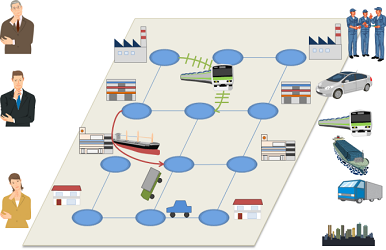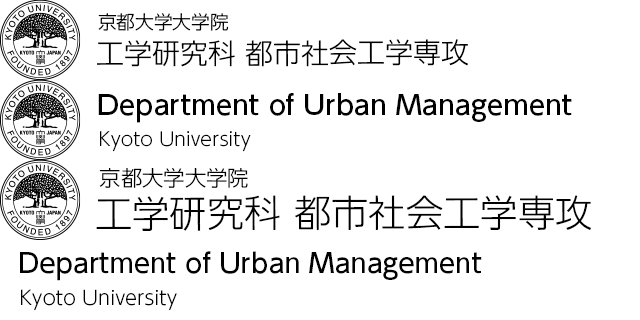Intelligent Transport Systems
Utilizing information technologies like ITS (Intelligent Transport Systems), we have been developing efficient procedures to settle transport and logistics problems in urban areas. We are dealing with various research topics; including traffic flow modeling, transport and supply chain network design, effective operation, management and control of transport systems, and behavior analysis on private car users, public transport users and tourism.
Academic Staff
Tadashi YAMADA
Professor (Graduate School of Engineering)
Research Topics
I have been investigating the improvement and optimisation of transport and logistics systems, as well as exploring the key factors to develop the effective ones.
Current research topics involve the optimal design of transport, logistics, and supply chain networks towards enhancing their resilience and creating efficient multimodal networks.
Contacts
Room 435, C1-2, Katsura Campus
TEL: +81-75-383-3233
FAX: +81-75-383-3236
E-mail: yamada.tadashi.2x kyoto-u.ac.jp
kyoto-u.ac.jp
Jan Dirk SCHMOECKER
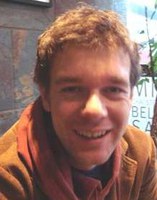 Associate Professor (Graduate School of Engineering)
Associate Professor (Graduate School of Engineering)
Research Topics
My main research topic is modelling of passenger behavior in networks including aspects such as fare structures, crowding, bunching and real-time information. Connected to this are research interests in demand adaptation to transport infrastructure investments, technological advances and trends such as "shared mobility" or "mobility as a service".
Contacts
Room 436, C1-2, Katsura Campus
FAX: +81-75-383-3236
E-mail: schmoecker trans.kuciv.kyoto-u.ac.jp
trans.kuciv.kyoto-u.ac.jp
Satoshi NAKAO
Assistant Professor (Graduate School of Engineering)
Research Topics
Transport is closely related to people's lives, politics, economy, and society. To solve traffic problems, we need comprehensive, cross-disciplinary approach. Therefore, my research is focusing on not only analytical approaches but also approaches based on folklore and history.
Contacts
Room 434, C1-2, Katsura Campus
TEL: +81-75-383-3235
FAX: +81-75-383-3236
E-mail: nakao trans.kuciv.kyoto-u.ac.jp
trans.kuciv.kyoto-u.ac.jp
Research Topics
Utilizing Big Data to understand travel patterns
Nowadays a large amount of data have become available to the transport analyst. IC card data tell us the boarding and alighting points of passengers. ETC data provide us with information for car drivers. Mobile phone data can be used to understand how many people are where during different time periods. GPS bus data give us information about bus locations and service regularity (the figure on the left shows Kyoto’s bus lines obtained from GPS data). Truck data obtained via GPS or digital tachograph can indicate truck routing and scheduling. Other sensors in-stalled within the city can help us understanding the walking pattern of people. We aim to utilise such data in an efficient way with novel analysis methodologies.
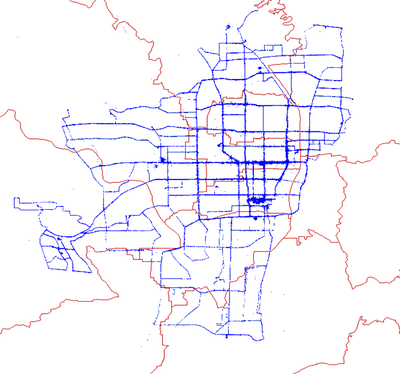
Modeling network flows for public and shared transport systems
Data often build the basis for subsequent network flow models. In other cases we start from theoretical models to gain general insights into efficiencies of networks. The figure on the left shows a model of a bus stop to reflect that only some of the newly boarding passengers will be able to find a seat. Extending this model to a network helps us understanding the effect of, for example, service frequency changes. We create multimodal network flow models especially considering the growing importance of car sharing, cycle sharing, cooperative freight transport systems, and other technological developments that influence network flows such as autonomous vehicles.
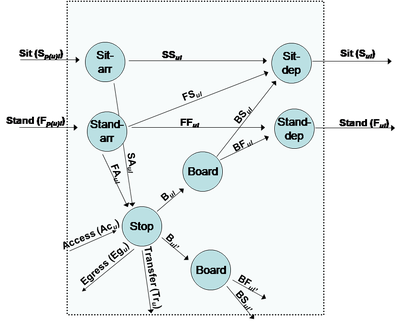
Network design for transport and supply chain
Passengers and freight move on a transport network (TN). Designing optimal TNs is therefore efficient for alleviating or settling urban and regional transport problems.
In the case of designing an optimal TN in terms of logistics, we need to take into account the decisions on logistics typically made looking over an entire supply chain network (SCN). Therefore, accurate comprehension of what happens on the SCN, namely, precisely describing the behavior of economic entities in the SCN and the resulting flow of products (and of raw materials as well) is necessary to understand the mechanism of the generation of freight movement. We are developing mathematical models to represent the behavior of manufacturers, wholesalers, retailers, consumers and freight carriers. The behavior of passengers is also incorporated within the models as well as the behavioral interaction between passenger and freight traffic. This approach is a sort of supernetwork modeling. We are also tackling the development of AI-based optimization techniques capable of solving large-sized problems.
